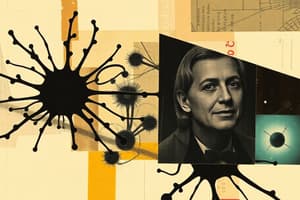Podcast
Questions and Answers
What is the primary function of ligand-gated ion channels once a ligand binds?
What is the primary function of ligand-gated ion channels once a ligand binds?
- To bind specifically to hydrophilic ligands
- To phosphorylate other proteins in the cell
- To form a channel that allows ions to flow passively (correct)
- To inhibit the flow of ions across the membrane
Which type of receptor typically contains an enzymatic domain that is a protein kinase?
Which type of receptor typically contains an enzymatic domain that is a protein kinase?
- G-protein coupled receptors
- Ligand-gated ion channels
- Intracellular receptors
- Enzyme-coupled receptors (correct)
What triggers the activating change in G-protein coupled receptors once a ligand binds?
What triggers the activating change in G-protein coupled receptors once a ligand binds?
- The formation of ion channels
- A conformational change in the receptor (correct)
- The release of tyrosine kinase
- The production of GDP
What must happen to the alpha subunit of G proteins for it to become active?
What must happen to the alpha subunit of G proteins for it to become active?
What characteristic distinguishes G-protein coupled receptors from other types of receptors?
What characteristic distinguishes G-protein coupled receptors from other types of receptors?
Intracellular receptors primarily bind to which type of ligands?
Intracellular receptors primarily bind to which type of ligands?
Enzyme-coupled receptors undergo a conformational change primarily to:
Enzyme-coupled receptors undergo a conformational change primarily to:
Which of the following statements about intracellular receptors is true?
Which of the following statements about intracellular receptors is true?
Which second messenger is activated by DAG?
Which second messenger is activated by DAG?
What does the term 'potency' refer to in pharmacology?
What does the term 'potency' refer to in pharmacology?
How is efficacy defined among medications?
How is efficacy defined among medications?
What happens at the EC50 point on a dose-response curve?
What happens at the EC50 point on a dose-response curve?
In a dose-response curve, what does a curve closer to the left indicate?
In a dose-response curve, what does a curve closer to the left indicate?
Which of the following G proteins inhibits adenylate cyclase?
Which of the following G proteins inhibits adenylate cyclase?
What is the primary function of phospholipase C when activated by Gq proteins?
What is the primary function of phospholipase C when activated by Gq proteins?
Which medication characteristic does not affect affinity?
Which medication characteristic does not affect affinity?
What shape does a typical dose-response curve take?
What shape does a typical dose-response curve take?
Between medications C and D, which is described as more efficacious?
Between medications C and D, which is described as more efficacious?
Flashcards are hidden until you start studying
Study Notes
Intracellular Receptors
- Located in the cytoplasm or nucleus of cells
- Bind to small, hydrophobic ligands, such as steroids
- Receptor-ligand complex binds to specific DNA sequences
- This interaction activates or inhibits specific genes
Cell-Surface Receptors
- Embedded in the plasma membrane
- Bind to ligands that are too large or hydrophilic to pass through the membrane
- Three main types: ligand-gated ion channels, enzyme-coupled receptors, and G-protein coupled receptors
Ligand-gated Ion Channels (Ionotropic Receptors)
- Form channels or pores that are closed in the absence of a ligand
- Binding of a ligand opens the channel, allowing ions (chloride, calcium, sodium, potassium) to pass through
- Ions flow passively down their concentration gradients
- This triggers downstream signaling pathways
Enzyme-coupled Receptors
- Usually single-pass transmembrane proteins
- Extracellular domain binds to ligands
- Intracellular domain has enzymatic activity, typically protein kinase (tyrosine kinase)
- Ligand binding triggers conformational changes, creating high-affinity binding sites for second messengers
- Tyrosine kinases phosphorylate second messengers, activating other proteins in the signaling pathway
G-protein Coupled Receptors (Seven-Pass Transmembrane Receptors)
- Long proteins with one end outside the cell and seven transmembrane segments
- Ligand binding on the extracellular end activates guanine nucleotide-binding proteins (G proteins)
- G proteins have alpha, beta, and gamma subunits
- Alpha subunit binds to GDP in the inactive state
- Ligand binding causes the alpha subunit to release GDP and bind GTP
- This activation causes the alpha subunit to detach and trigger other proteins in the signaling pathway
Types of G Proteins
- Gq, Gi, and Gs
- Each type has a unique alpha subunit
- Gq activates phospholipase C
- Gs and Gi stimulate or inhibit adenylate cyclase, respectively
Second Messengers
- IP3, DAG, and cAMP
- Produced by the action of G proteins and their target enzymes
- IP3 and DAG are produced by phospholipase C
- cAMP is produced (or inhibited) by adenylate cyclase
- Activate or inhibit various enzymes and molecular pathways
Medication-Receptor Interactions
- Three key principles: affinity, potency, and efficacy
Affinity
- Strength of the binding interaction between a medication and its receptor
- Determined by the chemical bond between the two molecules
- Higher affinity generally corresponds to a stronger interaction
Potency
- Amount of medication needed to produce a specific effect
- High potency requires a lower dose for a given effect
- Affinity is directly proportional to potency
Efficacy
- Maximum effect a medication can produce
- Measured by the Emax (maximum response) on a dose-response curve
- Higher efficacy corresponds to a greater maximum response
Dose-Response Curve
- Graph showing the relationship between medication concentration (dose) and the response produced
- Typically S-shaped (sigmoidal)
- X-axis: medication concentration (logarithmic scale)
- Y-axis: response
EC50
- Median effective concentration
- Concentration of medication that produces 50% of the maximum effect (Emax)
- EC50 is inversely proportional to potency
Comparing Medications
- Higher potency corresponds to a lower EC50 on the dose-response curve (curve shifted left)
- Higher efficacy corresponds to a higher Emax on the dose-response curve (curve shifted upward)
Studying That Suits You
Use AI to generate personalized quizzes and flashcards to suit your learning preferences.




